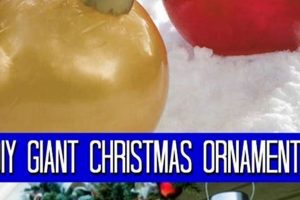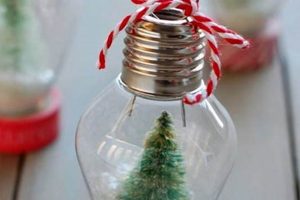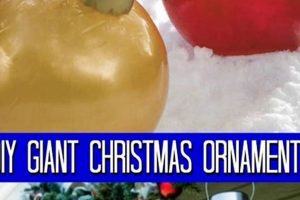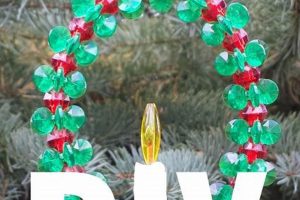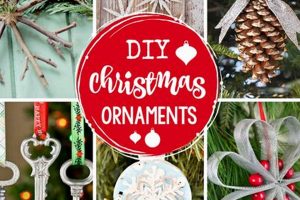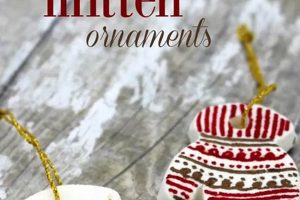Handcrafted decorations fashioned from wool fibers, typically created at home, represent a personalized approach to holiday adornment. These items offer an avenue for individual expression and artistic exploration during festive seasons, resulting in unique and cherished keepsakes. For example, a felt star, a whimsical animal figure, or a miniature representation of a meaningful object can be meticulously crafted and hung on a tree or used to embellish gift packages.
The creation of such items presents a tangible connection to craft traditions, fostering creativity and providing a sense of accomplishment. The process can be a calming and meditative activity, offering a respite from the demands of modern life. Historically, the use of felt in decoration extends back centuries, reflecting a resourcefulness and appreciation for natural materials. These handmade elements imbue celebrations with warmth and authenticity, contrasting with mass-produced alternatives.
The following sections will delve into specific techniques for constructing these decorations, discuss material selection and preparation, and offer a range of design ideas to inspire both novice and experienced crafters. Furthermore, considerations for safety and sustainability within the crafting process will be addressed.
Essential Guidance for Creating Handcrafted Wool Decorations
The successful creation of handcrafted wool decorations hinges on careful preparation, precise execution, and a commitment to quality materials. The following guidance will assist in optimizing the crafting process.
Tip 1: Select High-Quality Wool. Opt for wool roving or batting that is minimally processed. This ensures optimal felting and a desirable finished texture. Merino wool is often favored for its softness, while coarser wools may provide additional structure.
Tip 2: Employ Appropriate Needles. Utilize felting needles specifically designed for the task. Different gauges of needles are suitable for different stages of the process. Finer needles are effective for detailed work and surface finishing, while coarser needles expedite the initial felting process.
Tip 3: Practice Controlled Needle Insertion. Insert the felting needle straight into the wool and withdraw it along the same path. Angling the needle can lead to breakage. Maintain a consistent depth of penetration to achieve uniform felting.
Tip 4: Utilize a Dense Foam Surface. A firm, dense foam pad is essential for protecting work surfaces and preventing needle breakage. Ensure the pad is large enough to accommodate the project and provides adequate support.
Tip 5: Build Forms Gradually. Avoid attempting to felt large shapes from a single mass of wool. Instead, build forms gradually by adding small layers of wool and felting them together. This allows for greater control over the shape and density of the finished piece.
Tip 6: Consider Wet Felting Techniques. Wet felting, which involves the use of warm water and soap, can be combined with needle felting to achieve a smoother, denser finish. This technique is particularly useful for creating flat shapes or embellishments.
Tip 7: Secure Attachments Firmly. When attaching multiple pieces together, ensure the wool fibers are thoroughly interlocked through repeated needling. Reinforce attachment points with additional wool if necessary.
Adherence to these guidelines promotes the creation of durable and aesthetically pleasing wool decorations, enhancing their longevity and visual appeal.
The ensuing sections will address advanced techniques, design considerations, and methods for preserving the integrity of handcrafted wool decorations over time.
1. Material Quality
The selection of materials directly impacts the aesthetic appeal, durability, and tactile quality of handcrafted felted ornaments. Careful consideration of fiber characteristics is paramount to achieving desired results.
- Fiber Type and Composition
The composition of the wool fiber dictates its felting properties. Merino wool, characterized by its fine fibers, yields a soft, luxurious texture suitable for delicate ornaments. Conversely, coarser wools, such as those from Shetland sheep, provide a more robust structure and are ideal for ornaments requiring greater durability. Fiber blends can be employed to achieve intermediate textures and performance characteristics. The inclusion of synthetic fibers can enhance strength and resistance to pilling but may compromise the natural feel of the finished product.
- Dyeing and Colorfastness
The dyeing process and the inherent colorfastness of the dyes used are critical factors. Ornaments constructed with dyes that exhibit poor colorfastness are susceptible to fading or bleeding when exposed to light or moisture. This can detract from the ornament’s appearance and potentially stain surrounding materials. Opting for wool that has been dyed with lightfast and washfast dyes ensures long-term color retention and vibrancy. Natural dyes, while often possessing a more subdued palette, can offer excellent colorfastness and environmental benefits.
- Fiber Preparation and Cleanliness
The preparation of the wool prior to felting significantly influences the final product’s appearance and integrity. Wool that has been properly cleaned and carded, removing impurities and aligning the fibers, felts more readily and produces a smoother, more uniform surface. The presence of vegetable matter or excessive grease can impede the felting process and compromise the ornament’s overall quality. Scouring and carding are essential steps in preparing raw wool for crafting.
- Fiber Consistency and Staple Length
Consistency in fiber diameter and staple length is crucial for achieving a uniform felted surface. Variations in fiber thickness can lead to uneven felting and a less aesthetically pleasing result. Similarly, inconsistent staple lengths can impact the felt’s structural integrity and susceptibility to pilling. Selecting wool from a single source or carefully blending different wools can mitigate these issues and ensure a consistent, high-quality finished product.
In conclusion, the inherent characteristics of the chosen wool, encompassing fiber type, dyeing process, preparation, and consistency, exert a profound influence on the final result. Thoughtful material selection elevates the overall quality and longevity of handcrafted felted decorations.
2. Needle Felting Technique
Needle felting technique serves as the core method in the creation of felted decorations. The technique, involving the repeated stabbing of wool fibers with specialized barbed needles, causes interlocking and entanglement, forming a dense, cohesive material. Without this process, the creation of three-dimensional felted forms is not feasible. The depth, angle, and frequency of needle penetration directly influence the density, shape, and overall structural integrity of the resulting item. For instance, crafting a detailed felted bird requires precise application of the technique to define the beak, feathers, and overall form; inconsistent application leads to a misshapen and structurally unsound piece.
Variations in needle felting technique can significantly impact the aesthetic and tactile qualities of the finished decoration. Dry needle felting, the most common approach, produces a firm, sculptural result. Wet felting, often used in conjunction with needle felting, employs moisture and agitation to further bind the fibers, creating a smoother, more uniform surface. The choice of needle gauge also affects the final texture; finer needles create a more refined surface, while coarser needles facilitate faster felting of larger volumes. Furthermore, the technique allows for intricate detail work, enabling the creation of personalized and highly realistic decorations, mirroring objects or creatures with accuracy.
Effective implementation of needle felting technique requires practice and attention to detail. Challenges include needle breakage due to improper angle or excessive force, uneven felting leading to structural weaknesses, and difficulty achieving smooth surfaces. Mastering these challenges necessitates a thorough understanding of fiber behavior and careful manipulation of the felting needle. Ultimately, the needle felting technique is not merely a method of fabrication; it is the foundational skill that enables the creation of durable, aesthetically pleasing, and personally meaningful handcrafted wool decorations. The quality of the technique dictates the final outcome and the longevity of the art piece.
3. Form Construction
Form construction is the foundational element in the creation of durable and aesthetically pleasing decorations from felted materials. The method by which the three-dimensional shape of the ornament is built dictates its structural integrity, visual appeal, and overall longevity. A poorly constructed form is prone to deformation, fiber separation, and a lack of visual clarity, regardless of the quality of materials used. Consider, for example, a felted snowman ornament. If the core form is not properly compacted and shaped, the snowman may appear lopsided, lack definition in its features, and ultimately disintegrate with handling. Proper form construction, therefore, represents a critical stage in the crafting process, influencing the long-term viability of the decorative item.
Various techniques exist for achieving effective form construction. A common approach involves building the ornament around a core material, such as tightly wrapped wool roving or a pre-shaped foam ball. This provides a stable base upon which to apply additional layers of felt, gradually shaping the desired form. Alternatively, the form can be constructed entirely from layers of felt, carefully built up and compacted through needle felting. This method allows for greater control over the final shape and density of the ornament. Regardless of the chosen technique, attention must be paid to evenly distributing the wool fibers and ensuring thorough entanglement to create a cohesive and resilient form. Proper form construction also influences the integration of embellishments. A solid form ensures secure anchoring of beads, sequins, or other decorative elements, preventing them from detaching over time. A well-defined form also allows for greater precision in the placement of these embellishments, enhancing the overall aesthetic appeal of the piece.
In summary, effective form construction is indispensable to the creation of enduring and visually appealing handcrafted felted decorations. The process directly affects the structural integrity, aesthetic clarity, and long-term preservation of the finished item. Mastering form construction techniques enables crafters to produce ornaments that not only possess immediate visual appeal but also withstand the test of time. Conversely, neglecting this crucial step undermines the overall quality and longevity of the decoration, regardless of other artistic considerations.
4. Color Palette Selection
The strategic selection of colors significantly influences the aesthetic impact and perceived value of felted ornaments. The chosen palette dictates the ornament’s visual harmony, evoking specific emotions or associations, and influencing its integration within a broader decorative scheme. Mismatched or poorly considered color combinations detract from the ornament’s appeal, potentially rendering a well-crafted piece visually unappealing. Conversely, a carefully curated color palette enhances the ornament’s visual presence, elevating its perceived quality and artistic merit. For instance, a traditional Christmas-themed ornament employing shades of red, green, and gold evokes feelings of warmth and festivity, while a muted, monochromatic palette may convey a sense of minimalist elegance.
The application of color theory principles further enhances the effectiveness of palette selection. Understanding complementary, analogous, and triadic color schemes allows for the creation of visually balanced and engaging ornaments. A knowledge of color psychology informs the selection of colors that align with the desired emotional response. Pastel shades, for example, often convey a sense of gentleness and tranquility, while bolder, more saturated colors evoke energy and excitement. Practical application involves considering the ornament’s intended placement and the existing color scheme of its surroundings. An ornament intended for a brightly decorated tree may benefit from a bolder palette to stand out, while one intended for a more subdued setting may be better served by a more subtle color scheme.
In conclusion, color palette selection is not merely an aesthetic choice but a critical element that significantly impacts the overall effectiveness of felted ornaments. A thoughtful and informed approach, guided by color theory principles and contextual considerations, ensures that the chosen colors enhance the ornament’s visual appeal, evoke the desired emotional response, and seamlessly integrate into its intended environment. Neglecting this element can diminish the impact of even the most skillfully crafted felted piece, underscoring the practical significance of meticulous color planning.
5. Embellishment Integration
The integration of embellishments represents a critical step in the creation of handcrafted felted decorations. This process significantly enhances the aesthetic appeal, dimensionality, and perceived value of the ornaments, transforming simple felted forms into intricate works of art. The selection and application of embellishments require careful consideration to ensure visual harmony and structural integrity.
- Material Compatibility and Adhesion
The success of embellishment integration hinges on the compatibility of materials and the strength of adhesion. The embellishments should complement the texture and color of the felt, avoiding clashes that detract from the overall aesthetic. Secure adhesion is essential to prevent detachment during handling or storage. For instance, glass beads may be affixed using strong adhesive thread or specialized fabric glue, while felt appliques can be integrated through careful needle felting. Failure to consider material compatibility may result in weak bonds and premature detachment of embellishments.
- Dimensionality and Texture Enhancement
Embellishments provide an opportunity to introduce dimensionality and texture to otherwise flat felted surfaces. Beads, sequins, embroidery floss, and fabric scraps can be strategically applied to create visual interest and tactile sensations. A felted flower, for example, can be enhanced with embroidered stamen and beaded centers, adding depth and realism. Similarly, the surface of a felted animal can be textured using various needle felting techniques and applied fabric pieces to simulate fur or scales. Judicious use of embellishments elevates the ornament from a simple craft project to a more sophisticated artistic expression.
- Thematic Relevance and Narrative Enhancement
Embellishments can be used to reinforce the thematic narrative of the ornament and enhance its storytelling potential. A felted Santa Claus ornament, for example, can be embellished with miniature bells on his hat, a tiny sack filled with felt presents, and embroidered details on his coat. These elements contribute to the overall character and story of the ornament, making it more engaging and memorable. Choosing embellishments that align with the ornament’s subject matter adds depth and complexity to the design, transforming it from a mere decoration into a miniature work of art.
- Structural Reinforcement and Functional Integration
Beyond their aesthetic contributions, embellishments can also serve to reinforce structural weaknesses or integrate functional elements. Strategically placed beads or sequins can strengthen seams or conceal imperfections in the felted surface. Loops or ribbons for hanging the ornament can be seamlessly integrated through the embellishment process, ensuring a secure and visually appealing attachment point. This dual functionality enhances both the aesthetic and practical value of the embellishments, transforming them from purely decorative elements into integral components of the ornament’s design.
The facets discussed highlight the multifaceted role of embellishment integration in the creation of aesthetically rich and structurally sound handcrafted felted decorations. From material compatibility to thematic enhancement, the careful selection and application of embellishments elevates the final product from a simple craft item to a personally expressive artwork. Neglecting the nuances of this integration can detract from the ornament’s overall appeal, underscoring the importance of considered embellishment choices and execution in the crafting process.
6. Detail Precision
In the realm of “diy felted ornaments,” detail precision serves as a critical determinant of the finished product’s aesthetic appeal, realism, and overall quality. The level of attention afforded to minute elements directly impacts the ornament’s ability to accurately represent the intended subject, be it a character, object, or abstract design. Inadequate precision manifests as distortions, asymmetries, and a general lack of refinement, detracting from the ornament’s visual impact. For example, consider the creation of a felted robin ornament. The precise execution of feather details, beak shape, and eye placement contributes significantly to the robin’s recognizability and lifelike appearance. Conversely, poorly defined features result in a generic and less compelling representation. The cause-and-effect relationship is evident: meticulous attention to detail yields a superior ornament, while negligence diminishes the final product.
The practical significance of detail precision extends beyond mere aesthetics. Accurate detailing often necessitates the mastery of specific needle felting techniques, such as fine fiber layering and controlled needle penetration. These techniques, when applied with precision, not only enhance the visual realism but also improve the structural integrity of the ornament. For instance, the precise shaping and attachment of small appendages, such as arms or legs on a felted animal ornament, require careful attention to ensure both stability and proportional accuracy. Moreover, a commitment to detail precision fosters a greater appreciation for the craft, encouraging patience, skill development, and a deeper understanding of the materials and techniques involved. The process of achieving intricate detailing, therefore, transforms the creation of felted ornaments from a simple hobby into a refined art form.
In summation, detail precision is not merely a desirable attribute but an indispensable component of successful “diy felted ornaments.” Its influence extends from the initial design to the final execution, affecting both the aesthetic appeal and the structural integrity of the finished piece. While achieving high levels of precision may present challenges, requiring patience, skill, and specialized tools, the resulting improvements in the ornament’s quality and realism justify the effort. As such, detail precision should be regarded as a core principle for those seeking to create handcrafted felted decorations that are both visually stunning and enduring.
7. Finishing Touches
In the context of handcrafted felt decorations, the term “finishing touches” encompasses a series of refined procedures enacted upon the completion of the primary construction phase. These procedures, although often subtle, exert a significant influence on the final aesthetic appeal, structural integrity, and perceived professionalism of the ornament. A failure to adequately address these finishing steps can detract from the overall quality of an otherwise skillfully crafted piece. For example, the presence of stray fibers protruding from the ornament’s surface, if left untended, diminishes the clean lines and contributes to a perception of incompleteness. Similarly, uneven seams or loosely attached embellishments compromise the ornament’s structural soundness and aesthetic coherence. Therefore, the execution of finishing touches constitutes a non-negligible phase in the creation of felt ornaments.
The practical applications of meticulous finishing touches are varied. Trimming stray fibers with small, sharp scissors ensures a clean, polished appearance. Sealing seams with discreet stitches or specialized adhesives reinforces structural integrity and prevents unraveling. Careful placement and secure attachment of embellishments, such as beads or sequins, enhance the ornament’s visual complexity and prevent loss during handling. Furthermore, the application of protective coatings or sealants can enhance the ornament’s resistance to dust, moisture, and ultraviolet light, prolonging its lifespan and preserving its aesthetic qualities. Real-world examples illustrate this point effectively: an ornament with carefully trimmed seams and securely attached embellishments projects an image of professionalism and attention to detail, while an ornament lacking these finishing touches appears amateurish and less desirable.
In summary, finishing touches represent an essential component in the creation of high-quality felt ornaments. These subtle but critical procedures contribute significantly to the ornament’s aesthetic appeal, structural integrity, and perceived value. While the execution of finishing touches may require additional time and effort, the resulting improvements in the ornament’s quality and longevity justify the investment. Challenges may arise in the form of selecting appropriate materials and techniques for specific types of felt and embellishments. However, the commitment to meticulous finishing touches elevates the craft of felt ornament creation, transforming it from a simple hobby into a refined art form.
Frequently Asked Questions About Handcrafted Wool Decorations
The following section addresses common inquiries regarding the creation, maintenance, and preservation of decorations crafted from felted wool.
Question 1: What is the optimal type of wool to utilize for crafting these ornaments?
Merino wool is frequently favored due to its softness and fine texture, rendering it suitable for intricate details. However, coarser wools, such as those derived from Shetland sheep, provide enhanced structural integrity for larger or more robust ornaments. Blending various wool types is also an option to achieve specific textures and performance characteristics.
Question 2: How does one prevent needle breakage during the felting process?
Employing proper technique is essential. Needles should be inserted and withdrawn vertically, avoiding angled insertion. A dense foam pad provides a suitable work surface, and the use of appropriately sized needles for the wool’s density minimizes breakage. Excessive force should be avoided.
Question 3: What methods exist for ensuring the long-term colorfastness of dyed wool?
Selecting wool dyed with lightfast and washfast dyes is paramount. Natural dyes, while offering a more limited palette, often exhibit excellent colorfastness. Avoiding prolonged exposure to direct sunlight can mitigate fading. Gentle cleaning methods are also recommended.
Question 4: How can one achieve smooth, uniform surfaces on felted ornaments?
Wet felting techniques, in conjunction with needle felting, promote a smoother, denser finish. The consistent application of pressure and moisture aids in fiber entanglement. Fine-gauge needles are more effective for refining surfaces and eliminating irregularities.
Question 5: What are the recommended procedures for cleaning felted ornaments?
Spot cleaning with a damp cloth and mild detergent is typically sufficient. Immersion in water should be avoided, as it can distort the shape and compromise the integrity of the felt. Air drying away from direct heat is recommended. Professional dry cleaning may be considered for heavily soiled ornaments.
Question 6: How can ornaments with intricate details be preserved against damage during storage?
Storing ornaments in acid-free tissue paper within a sealed container protects them from dust, moisture, and pests. Separating ornaments with padding prevents abrasion and entanglement. Avoiding exposure to extreme temperatures and humidity further minimizes the risk of damage.
Proper material selection, technique, and preservation methods are vital for the successful creation and maintenance of handcrafted wool ornaments.
The following section will explore advanced techniques and design considerations for further enhancing the artistry of handcrafted wool decorations.
Conclusion
The creation of “diy felted ornaments,” as explored, is a nuanced craft demanding careful consideration of materials, techniques, and finishing processes. Achieving aesthetically pleasing and structurally sound results requires adherence to principles of fiber selection, precise needle manipulation, form construction, color theory, embellishment integration, detail execution, and refined finishing. The information presented serves as a guide for individuals seeking to engage in this craft, highlighting critical aspects that directly influence the quality and longevity of the finished product.
The creation of handcrafted decorations fosters creativity and provides a tangible connection to craft traditions, offering a respite from the demands of modern life. The diligent application of the principles and techniques discussed contributes to the perpetuation and enhancement of this craft. This effort ensures the creation of cherished keepsakes that reflect individual artistry and embody a rich heritage of handmade artistry.


